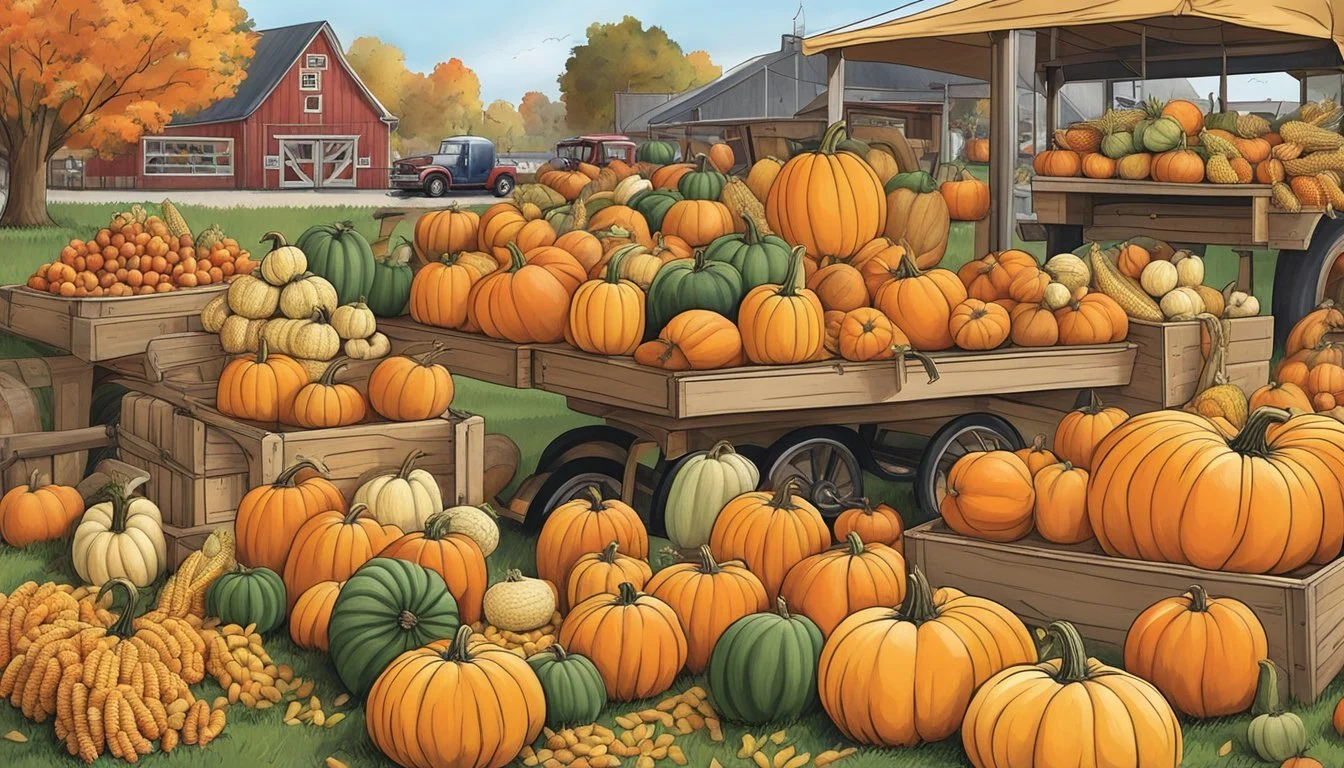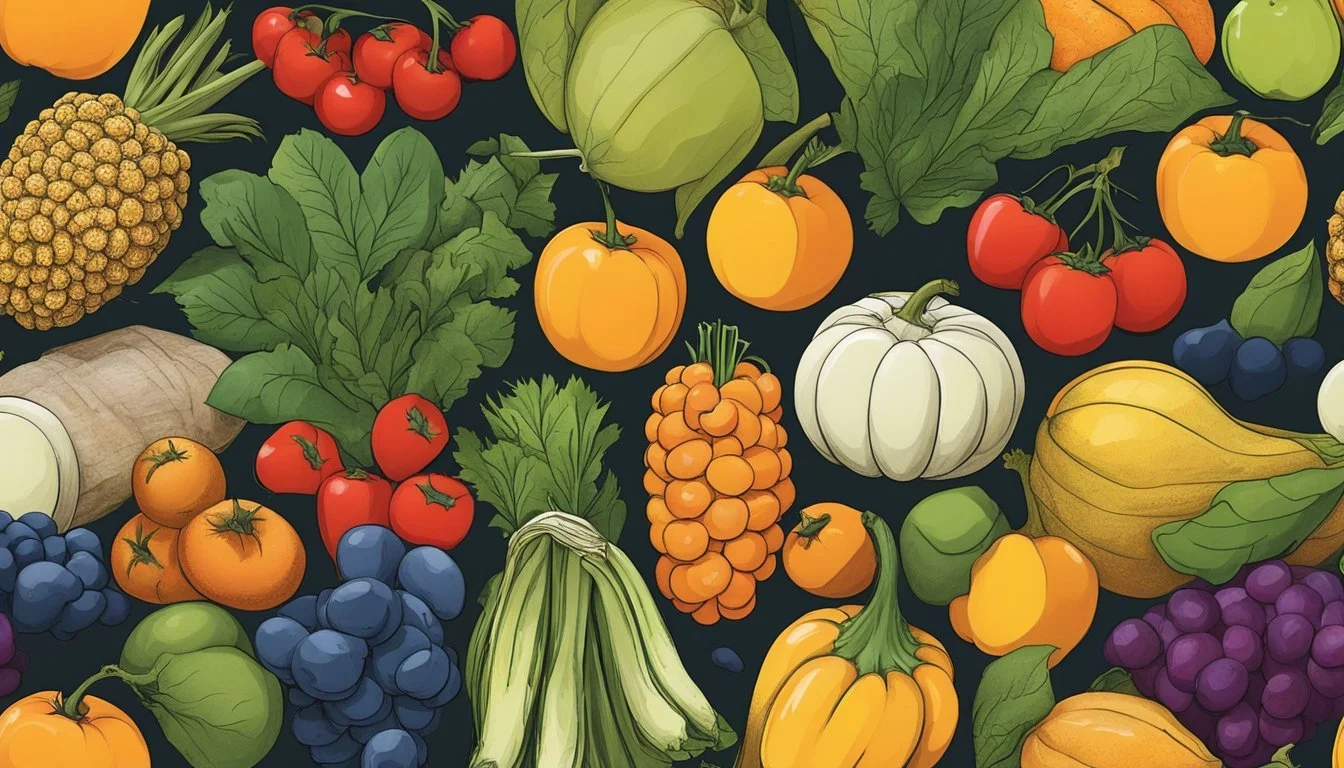Minnesota Seasonal Fruit & Vegetables in October
Your Ultimate Harvest Guide
This Article is Part of our Minnesota Seasonal Fruit & Veg Calendar
In Minnesota, October heralds a season of robust harvests and the final weeks of fresh produce before winter sets in. For those who relish locally-grown fruits (What wine goes well with fruit?) and vegetables, this month offers a bountiful array of choices. Root vegetables and hardy autumn produce dominate the scene. Carrots (how long do carrots last?), harvested from June, remain a staple through October, offering their earthy sweetness to a variety of dishes. Similarly, beets and potatoes, staples of the Minnesotan diet, are available fresh from the fields, their flavors unparalleled when compared to their stored counterparts.
October's chill also brings out the best in cruciferous vegetables like Brussels sprouts (how long do brussels sprouts last?)and cauliflower (how long does cauliflower last?). They stand as a testament to Minnesota's rich agricultural tradition, thriving in the cooler temperatures and bringing warmth and nutrition to the table. With the state's short growing season wrapping up, these vegetables are a celebration of the harvest's final push.
While the focus is often on vegetables, one must not overlook the late-season fruits such as raspberries and apples (how long do apples last?). Minnesota's apple orchards are in full swing, with a variety of apples (how long do apples last?) from tart to sweet ready for picking. These fruits, synonymous with autumn, not only serve as fresh, crisp snacks but also inspire a host of traditional recipes, from pies to ciders, marking October as a time of gastronomic delight rooted deeply in the seasonal rhythms of the North Star State.
Seasonal Produce Overview
October in Minnesota is a vibrant time for produce, with a variety of fruits and vegetables reaching their peak ripeness. This guide offers a focused glimpse into what's in season during this fall month.
Fruits
Apples: Varied types like Honeycrisp and SweeTango.
Grapes: Typically ripe and ready for harvest.
Plums: Reach peak season in early fall.
Pumpkins: Though often associated with decoration, they are a nutritious fruit.
Cranberries: Harvest generally begins in October.
Vegetables
Broccoli (how long does broccoli last?): Remains in season and provides hearty nutrients.
Cabbage: Commonly used in fall dishes, fresh in October.
Cauliflower: Offers versatility in autumnal recipes.
Sweet Potatoes: A staple root vegetable during fall.
Winter Squash: Includes varieties like acorn, butternut, and spaghetti.
Kale: Cooler temperatures enhance its flavor.
Brussels Sprouts: Develops a sweeter taste after a light frost.
Garlic: Freshly harvested in the month.
Carrots: Cold snap can improve their sweetness.
Health Benefits and Nutrition
Eating seasonally in October provides diverse nutrient profiles from an array of fruits and vegetables, which are essential for maintaining optimal health. Each category boasts a unique set of vitamins, minerals, and fiber content that specifically benefits one's diet.
Fruits Nutritional Profile
Pumpkin: A fruit that is rich in vitamins A and C, pumpkin contributes to immune system support and skin health. It is also high in fiber, aiding in digestion.
Apples: Apples are high in fiber, which promotes heart health, and contain vitamin C, which serves as an antioxidant.
Pears: Packed with fiber, pears support digestive health and also offer vitamin C for immune function.
Cranberries: These berries are noteworthy for their vitamin C content and have unique antioxidants linked to urinary tract health.
Vegetables Nutritional Profile
Sweet Potatoes: They are an excellent source of vitamin A, which is vital for vision and the immune system, and contain a good amount of fiber for digestive health.
Butternut Squash: (how long does butternut squash last?) Similar to pumpkin, butternut squash is high in vitamins A and C, and also provides a considerable amount of fiber.
Broccoli: Broccoli offers an abundant supply of vitamins C and K, and it has a rich fiber profile that supports digestive health.
Brussels Sprouts: These vegetables are dense with nutrients, notably vitamins C and K, and they boast dietary fiber for gut health.
Cauliflower: Cauliflower is high in fiber and contains vitamins C and K, which supports overall bodily functions.
Consuming a variety of fruits and vegetables in October from Minnesota's harvest can contribute to a nutritionally well-rounded diet that supports good health.
Seasonal Recipes
In October, Minnesota's bounty offers a plethora of ingredients suitable for a variety of recipes. Utilizing seasonal produce, one can create dishes that embody the essence of fall, ensuring meals are fresh and flavors are at their peak.
Fruit Dishes
Salads: Pear and apple slices add a sweet crispness to salads, often paired with walnuts and a vinaigrette dressing.
Cobbler: A classic apple cobbler, with a crumbly topping, celebrates the season's harvest.
Jam: Homemade apple or pear jam captures the essence of autumn fruit.
Tarts: Rustic tarts filled with thinly sliced apples or pears, spiced with cinnamon, are a fall favorite.
Sauce: Apples simmered down into a chunky applesauce offer a simple, yet comforting side dish.
Vegetable Dishes
Roasted: Root vegetables such as parsnips and squashes can be roasted to perfection, bringing out their natural sweetness.
Soups: Butternut squash or pumpkin make for creamy, warming soups that are quintessential for cool October evenings.
Casserole: A vegetable casserole with layers of kabocha, leeks, and mushrooms offers a hearty main dish.
Curry: A variety of vegetables including eggplant (What wine goes well with eggplant?) and hot peppers can be used to prepare a spicy and aromatic curry.
Braised: Braising kale or chard creates a tender and flavorful side dish, with the greens absorbing the rich flavors of the cooking liquids.
Pancakes: Vegetables like broccoli can be incorporated into savory pancakes for an unexpected twist.
Pizza: Homemade pizzas topped with roasted vegetables like eggplant or kale are a celebration of the harvest.
Stews: A robust vegetable stew with parsnips, leeks, and mushrooms is comforting and nourishing on chilly days.
Harvest and Selection Tips
When visiting local markets in Minnesota during October, shoppers will find a bounty of freshly harvested produce. They should be mindful of the typical harvest times to ensure they are selecting the freshest possible fruits and vegetables.
Root Vegetables: October is a prime time for root vegetables. Shoppers can expect to find carrots, turnips, and beets with vibrant colors and firm textures, indicating freshness.
Selection: Look for firm roots and smooth skin.
Storage: Root vegetables should be stored in a cool, dark place.
Freshness: Understanding crop availability helps in selecting the freshest produce. Apples are abundant in October and should feel firm to the touch with no soft spots. Similarly, pumpkins and squash should have a hard skin, which indicates maturity and freshness.
Apple Selection: Choose apples with a firm feel and no bruising.
Pumpkin & Squash: Prefer specimens with a rich color and intact stem.
Market Guide: Visitors to farmers markets should seek out the following crops, confident that they are picking seasonally appropriate and fresh options.
Vegetables Fruits Brussels Sprouts Apples Kale Cranberries Cauliflower Pears
Each market visit should focus on the seasonal crops for the best quality. Buyers can often converse with growers to gain insights on peak harvest times for particular crops, adding depth to their market guide knowledge. As Minnesotans engage with the local produce available in October, they can take pride in the rich harvest and the agricultural prowess of the region.
Preservation and Storage
In Minnesota, October marks a transition period for seasonal fruits and vegetables, making proper preservation and storage critical for extending their shelf-life. Apples, often abundant in October, are best kept in a cool, dark place; ideally in a refrigerator where they can last several weeks.
Root vegetables like carrots and beets benefit from storage in a cool, humid environment, such as a root cellar. If one is not available, they can be stored in perforated plastic bags in the refrigerator. Potatoes should be kept in a dark, cool, and well-ventilated space to prevent sprouting.
For preserving the harvest, turning produce into jam is a popular method. Fruits, particularly berries, can be cooked down with sugar and pectin (how long does pectin last?), then sealed in sterilized jars. This process not only extends the fruits' shelf-life but also offers a taste of summer during the colder months.
Soups offer another preservation method, especially for a medley of late-harvest vegetables. Soups can be prepared, cooled, and then frozen, providing nutritious and easy-to-reheat meal options.
When it comes to seeds from fruits and vegetables, they should be thoroughly dried and stored in a cool, dry place until they are ready to be planted next season.
Techniques for Preservation:
Jam-Making: Simmer fruit with sugar and pectin; seal in jars
Freezing: Blanch vegetables, cool, and store in airtight containers
Canning: Use pressure canning for low-acid vegetables and water bath canning for high-acid fruits and tomatoes
Proper preservation and storage techniques allow Minnesotans to enjoy their local produce well beyond the harvest season, ensuring a supply of nutritious and flavorful fruits and vegetables throughout the year.
Local Markets and Farms
October in Minnesota brings a harvest of crisp apples, plump pumpkins, and a variety of root vegetables. Consumers looking for fresh, locally-grown produce have plenty of options through community markets and local farms.
Farmers' Markets
In Minnesota, farmers' markets are a cornerstone for local produce exchange. They often feature a wide array of seasonal vegetables, fruits, and other local products. As the weather cools, these markets adjust their offerings to include October's bounty. Markets in the Twin Cities and surrounding areas, such as Minneapolis, St. Paul, and Bloomington, remain active during this month, providing consumers with access to fresh, locally-sourced produce before the winter season.
Examples of produce available in October:
Apples
Pumpkins
Squashes
Root vegetables such as beets and carrots
Pick-Your-Own Farms
For those who prefer a hands-on approach to their food, pick-your-own farms offer a unique experience. Minnesota hosts a variety of these farms, where visitors can gather their own fresh fruits and vegetables straight from the vine or the tree. During October, these outings become especially popular for families and groups looking to participate in the harvest of seasonal crops like pumpkins and apples. Not only does this support local agriculture, but it also connects consumers more directly with the source of their food.
Activities often available at pick-your-own farms:
Apple picking
Pumpkin harvesting
Corn mazes
Hayrides
By visiting local markets and farms, Minnesotans foster community connections and support the local economy, all while enjoying the freshest produce the season has to offer.
Environmental Considerations
In Minnesota, October's cooler weather impacts both the production and selection of local fruits and vegetables. This shift in season prompts a greater emphasis on eco-friendly practices and sustainability in agriculture.
Sustainable Farming
Minnesota farmers often adopt sustainable farming methods to cope with the October climate while minimizing the impact on the air and surrounding environment. Cover cropping is a strategy used to protect the soil from erosion and to help maintain its quality during the off-season. Additionally, crop rotation and reduced tillage are implemented to enhance soil health and biodiversity. The integration of these practices not only supports the ecosystem but also prepares the land for resilient future harvests.
Seasonal Eating Benefits
Eating seasonally and locally in October supports eco-friendly initiatives and helps reduce the environmental footprint associated with food transport. Minnesotans benefit from a variety of root vegetables and squash that are in season and can be harvested before the frost sets in. These vegetables have a lower environmental impact as they require less energy for storage and transport compared to off-season imports. The table below outlines a few seasonal options for October:
Seasonal Vegetable Harvest Period Carrots Through October Beets Through October Squash September through October Garlic August through November
Farmers' markets become prime locations for consumers to purchase seasonal produce directly from growers, thereby encouraging local sustainability and reducing reliance on long-distance food supply chains.
Conclusion
October in Minnesota showcases a variety of seasonal produce that embodies the richness of fall harvests. Local markets brim with an assortment of fruits and vegetables that not only offer a panorama of flavors and textures but also invite Minnesotans to embrace seasonal eating.
Fruits in Season:
Apples: Renowned for their crispness and juiciness.
Pears: Known for their sweet and buttery flesh.
Cranberries: A fall staple, ideal for both sweet and savory dishes.
Vegetables in Season:
Pumpkins: Symbolic of fall and versatile in culinary uses.
Sweet potatoes: Nutrient-rich and comforting.
Brussels sprouts: They develop a sweeter taste post the first frost.
Eating seasonally supports local agriculture and ensures that consumers enjoy produce at its peak of freshness and nutritional value. October's offerings are particularly suited for hearty and warming meals that cater to the cooling temperatures.
Minnesota makes a commendable effort in providing a guide to seasonal eating, helping consumers make informed choices while fostering a community connected by locally-grown foods. The October produce array is a testament to the region's agricultural dedication and the bountiful harvest it yields.









